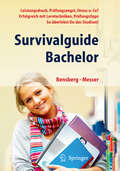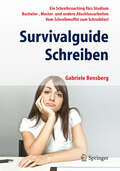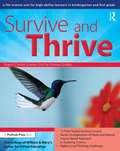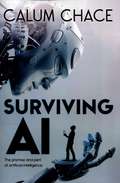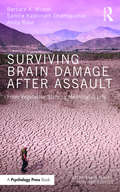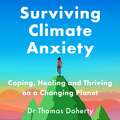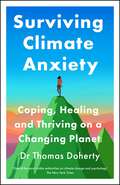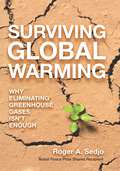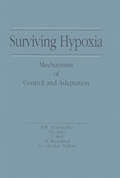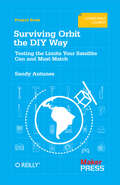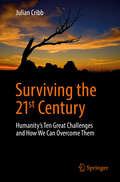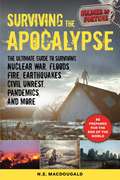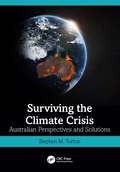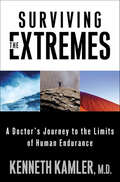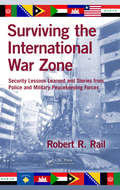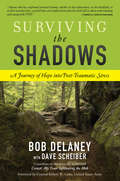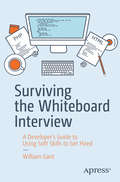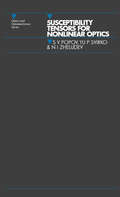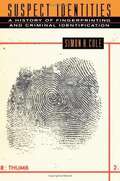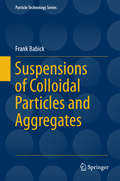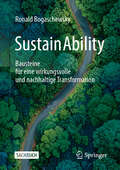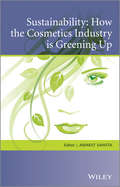- Table View
- List View
Survivalguide Bachelor. Leistungsdruck, Prüfungsangst, Stress und Co? Erfolgreich mit Lerntechniken, Prüfungstipps ... so überlebst Du das Studium
by Gabriele Bensberg Jürgen MesserDurch das Bachelor-Studium hat sich das Studieren verändert. Häufige Prüfungen und überfrachtete Studienpläne setzen Studierende unter Druck, die Prüfungsangst nimmt zu. Die Autoren leiten eine Beratungsstelle des Studentenwerks, sie kennen diese Nöte. In ihrem Ratgeber zeigen sie auf einfühlsame und humorvolle Weise, wie sich Studierende physisch und psychisch stärken können: durch Bewegung, Entspannungstechniken und Genuss. Sie vermitteln Strategien für effektives Lernen, für das Stressmanagement sowie Hilfen zur Bewältigung der Prüfungsangst.
Survivalguide Schreiben: Ein Schreibcoaching fürs Studium Bachelor-, Master- und andere Abschlussarbeiten Vom Schreibmuffel zum Schreibfan!
by Gabriele BensbergWenn Studierenden das Schreiben wissenschaftlicher Texte schwer fällt, kann es für sie zum Fluch werden - bis hin zur Angst, an der Abschlussarbeit zu scheitern. Die Autorin, erfahrene Studierenden-Beraterin und Schreibcoach, zeigt in diesem Buch, wie Studierende aufbauend auf ihren alltäglichen Schreibaktivitäten im Internet eine Brücke zum wissenschaftlichen Schreiben schlagen können. Das Buch bietet Handlungsanleitungen und Problemlösungen für alle Phasen der wissenschaftlichen Arbeit und dient darüber hinaus als psychologischer Begleiter.
Survive and Thrive: A Life Science Unit for High-Ability Learners in Grades K-1
by College of William & Mary's Centre for Gifted ChildrenSurvive and Thrive, a life science unit for grades K-1, provides students an opportunity to study animals, their characteristics, and their natural environments. The overarching concept of change guides students as they use webcams to distinguish the features of animals, determine their basic needs to survive, and observe animals in their habitats.Survive and Thrive was developed by the Center for Gifted Education at The College of William and Mary to offer advanced curriculum supported by years of research. The Center's materials have received national recognition from the United States Department of Education and the National Association for Gifted Children, and they are widely used both nationally and internationally.Each of the books in this series offers curriculum that focuses on advanced content and higher level processes. The science units contain simulations of real-world problems, and students experience the work of real science by using data-handling skills, analyzing information, and evaluating results. The mathematics units provide sophisticated ideas and concepts, challenging extensions, higher order thinking skills, and opportunities for student exploration based on interest. These materials are a must for any teacher seeking to challenge and engage learners and increase achievement.Grades K-1
Surviving AI: The Promise and Peril of Artificial Intelligence
by Calum ChaceArtificial intelligence is our most powerful technology, and in the coming decades it will change everything in our lives. If we get it right it will make humans almost godlike. If we get it wrong... well, extinction is not the worst possible outcome. "Surviving AI" is a concise, easy-to-read guide to what's coming, taking you through technological unemployment (the economic singularity) and the possible creation of a superintelligence (the technological singularity). Here's what some of the leading thinkers in the field have to say about it: A sober and easy-to-read review of the risks and opportunities that humanity will face from AI. Jaan Tallinn - co-founder of Skype Understanding AI - its promise and its dangers - is emerging as one of the great challenges of coming decades and this is an invaluable guide to anyone who's interested, confused, excited or scared. David Shukman - BBC Science Editor We have recently seen a surge in the volume of scholarly analysis of this topic; Chace impressively augments that with this high-quality, more general-audience discussion. Aubrey de Grey - CSO of SENS Research Foundation; former AI researcher It's rare to see a book about the potential End of the World that is fun to read without descending into sensationalism or crass oversimplification. Ben Goertzel - chairman of Novamente LLC Calum Chace is a prescient messenger of the risks and rewards of artificial intelligence. In "Surviving AI" he has identified the most essential issues and developed them with insight and wit - so that the very framing of the questions aids our search for answers. Chace's sensible balance between AI's promise and peril makes "Surviving AI" an excellent primer for anyone interested in what's happening, how we got here, and where we are headed. Kenneth Cukier - co-author of "Big Data" If you're not thinking about AI, you're not thinking. "Surviving AI" combines an essential grounding in the state of the art with a survey of scenarios that will be discussed with equal vigor at cocktail parties and academic colloquia. Chris Meyer - author of"Blur," "It's Alive," and "Standing on the Sun" The appearance of Calum Chace's book is of some considerable personal satisfaction to me, because it signifies the fact that the level of social awareness of the rise of massively intelligent machines has finally reached the mainstream. If you want to survive the next few decades, you cannot afford NOT to read Chace's book. Prof. Dr. Hugo de Garis - former director of the Artificial Brain Lab, Xiamen University, China "Surviving AI" is an exceptionally clear, well-researched and balanced introduction to a complex and controversial topic, and is a compelling read to boot. Sean O hEigeartaigh -executive director of Cambridge Centre for the Study of Existential Risk In"Surviving AI," Calum Chace provides a marvellously accessible guide to the swirls of controversy that surround discussion of what is likely to be the single most important event in human history--the emergence of artificial superintelligence. Throughout, "Surviving AI" remains clear and jargon-free. David Wood - chair of London Futurists Artificial intelligence is the most important technology of our era. Technological unemployment could force us to adopt an entirely new economic structure, and the creation of superintelligence would be the biggest event in human history. "Surviving AI" is a first-class introduction to all of this. Brad Feld - co-founder of Techstars"
Surviving Brain Damage After Assault: From Vegetative State to Meaningful Life (After Brain Injury: Survivor Stories)
by Barbara A. Wilson Samira Kashinath Dhamapurkar Anita RoseAt the age of twenty eight Gary was assaulted by a gang with baseball bats and a hammer, resulting in several skull fractures and severe brain damage. For nineteen months he had little awareness of his surroundings before he started to show some recovery. This inspirational book documents his exceptional journey. The book presents a series of interviews with Gary, his mother Wendie, who never gave up, the medical team who initially treated him, and the therapists who worked with him over a period of three years. Through their testimony we learn about the devastating effects which can follow a serious assault to the head, and the long process of recovery over several years. With specialist rehabilitation and continuing family support Gary has exceeded expectations and, apart from some minor physical problems, he is now a normal young man. Surviving Brain Damage after Assault shows that, contrary to popular belief, considerable gains can be made by people who have experienced a long period of reduced consciousness. The book will be of great value to all professionals working in rehabilitation - psychologists, speech and language therapists, occupational therapists, social workers and rehabilitation doctors, and to people who have sustained a brain injury and their families.
Surviving Chemistry Workbook: High School Chemistry (2015 Revision)
by Effiong EyoNewly revised for 2015. With New York State Regents Chemistry - The Physical Setting. A Highly organized workbook for every chemistry classrooms. With Four sections of chemistry work: Worksheets, Multiple Choices, and Constructed Responses. Student Benefits: Work on question sets for each concept you are learning. Test and evaluate your understanding of each concept. Well organized and less confusing problem sets
Surviving Climate Anxiety: Coping, Healing and Thriving on a Changing Planet
by Thomas DohertyClimate change anxiety is one of the biggest mental health threats of our times. If you find it hard to tear yourself away from doomscrolling, or it feels impossible not to worry about the world we are leaving to future generations, then you are not alone.Surviving Climate Anxiety is the essential guide to coping with the psychological toll of the environmental crisis.In this helpful and ground-breaking book, the world's leading climate anxiety expert, psychologist Dr Thomas Doherty, shares the pioneering techniques he has developed to help you to:- Reclaim your nervous system: manage your thoughts, feelings, and stress about climate change- Clarify your environmental identity: understand your history, values, and connection to the natural world- Overcome fear of climate disasters and tend to eco-depression and grief- Find realistic reasons for hope and ways to take meaningful actionPacked with practical, research-backed tips and dozens of stories - from the geologist haunted by images of melting glaciers, to the young couple agonizing over whether to bring a child into a world on fire, to a twenty-something wondering how to believe in the future - Surviving Climate Anxiety provides the tools to cope, heal, and flourish, even in these challenging times.
Surviving Climate Anxiety: Coping, Healing and Thriving on a Changing Planet
by Thomas DohertyClimate change anxiety is one of the biggest mental health threats of our times. If you find it hard to tear yourself away from doomscrolling, or it feels impossible not to worry about the world we are leaving to future generations, then you are not alone.Surviving Climate Anxiety is the essential guide to coping with the psychological toll of the environmental crisis.In this helpful and ground-breaking book, the world's leading climate anxiety expert, psychologist Dr Thomas Doherty, shares the pioneering techniques he has developed to help you to:- Reclaim your nervous system: manage your thoughts, feelings, and stress about climate change- Clarify your environmental identity: understand your history, values, and connection to the natural world- Overcome fear of climate disasters and tend to eco-depression and grief- Find realistic reasons for hope and ways to take meaningful actionPacked with practical, research-backed tips and dozens of stories - from the geologist haunted by images of melting glaciers, to the young couple agonizing over whether to bring a child into a world on fire, to a twenty-something wondering how to believe in the future - Surviving Climate Anxiety provides the tools to cope, heal, and flourish, even in these challenging times.
Surviving Global Warming: Why Eliminating Greenhouse Gases Isn't Enough
by Roger A. SedjoThis provocative and important overview of the challenges of and possible approaches to climate change by an expert and shared recipient of a Nobel Peace Prize is essential reading for policy makers, climate scientists, and lay persons alike. Though the Paris Agreement on climate change was a significant achievement, most authorities agree that its measures to reduce greenhouse-gas emissions will be insufficient to offset the forecasted increase in global warming. Even in the unlikely case of ideal compliance, the Earth will still experience major climate-driven damages. Given this reality, climate expert Roger A. Sedjo argues in this book that a Plan B is required. He makes a compelling case that doing more of the same, by focusing only on the mitigation plan of the Paris Agreement, will leave humanity increasingly vulnerable; instead, we must also begin planning adaptation strategies--Plan B--which enable societies to anticipate and protect against the worst effects of inevitable climate change. The author examines several areas where environmental damage could be severe. Sea-level rise is a major concern and measures could be, and in some cases are now being, undertaken to protect coastal areas. The author also addresses the need for more robust action to ward off the likely decline in agricultural productivity, destruction of forests and biodiversity, and the impact of natural catastrophes like hurricanes made worse by climate change. In addition, he considers geo-engineering strategies, such as atmospheric reflectivity, which may play a role in lessening the impact of global warming.
Surviving Hypoxia: Mechanisms of Control and Adaptation
by Peter L. Lutz Peter W. Hochachka Thomas J. Sick Myron RosenthalSurviving Hypoxia: Mechanisms of Control and Adaptation is a synthesis of findings and thoughts concerning hypoxia. The thermodynamics of hypoxia are discussed in detail, including acid-base balance and self-pollution resulting from the accumulation of anaerobic end-products. The book focuses on descriptions and discussions of common facets, contrasting solutions in a variety of physiological hypoxia defense strategies, including those shown by plants, invertebrates, and vertebrates. Special treatment is given to the distinctive problems that hypoxia presents to vulnerable organs such as the kidney, liver, and brain. It also addresses pathological events in addition to protective mechanisms. Clinical implications of basic research are examined in the book, which provides new insights into underlying pathological processes occuring in hypoxic-induced organ failure and indicates new paths for successful clinical intervention. Surviving Hypoxia: Mechanisms of Control and Adaptation is an excellent reference for all researchers interested in the physiological effects of hypoxia, underlying pathological events, and protective mechanisms.
Surviving Orbit the DIY Way: Testing the Limits Your Satellite Can and Must Match
by Sandy AntunesIs your picosatellite ready for launch? Can it withstand rocket thrusts and the vacuum of space? This do-it-yourself guide helps you conduct a series of hands-on tests designed to check your satellite’s readiness. Learn precisely what the craft and its electronic components must endure if they’re to function properly in Low Earth Orbit.The perfect follow-up to DIY Satellite Platforms (our primer for designing and building a picosatellite), this book also provides an overview of what space is like and how orbits work, enabling you to set up the launch and orbit support you’ll need.Go deep into the numbers that describe conditions your satellite will faceLearn how to mitigate the risks of radiation in the ionospherePick up enough formal systems engineering to understand what the tests are all aboutBuild a thermal vacuum chamber for mimicking environment of spaceSimulate the rocket launch by building and running a vibration shake testUse a homebuilt centrifuge to conduct high G-force testsGet guidelines on scheduling tests and choosing an appropriate lab or clean room
Surviving and Thriving in Postgraduate Research
by Ray Cooksey Gael McDonaldThis handbook provides an in-depth exploration of the entire journey of postgraduate research in the social and behavioural sciences, from enrolment to its culmination in the form of a thesis, dissertation or portfolio, and beyond. It is written in an accessible and example-rich style, offering practical and concrete advice in virtually all areas. It also includes references to additional resources and websites, and each chapter features key recommendations for improving the postgraduate research experience. The book addresses not only research-related aspects (e.g. supervisors; selecting your guiding assumptions; contextualising, framing and configuring research; reviewing literature; sampling; writing proposals; ethics and academic integrity; selecting a data gathering strategy; surviving your thesis/dissertation/portfolio examination; and publishing), but also questions concerning how to integrate, manage, and balance the research journey in the context of the postgraduate student’s broader life-world (e.g. skill development and supervisor relations; effective time and project management; a healthy work–life balance; maintaining motivation; and dealing with criticism). The book adopts an explicitly pluralist perspective on postgraduate research, moving beyond mixed methods thinking, and offers concrete examples from postgraduate students’ real-world experiences.
Surviving the 21st Century: Humanity's Ten Great Challenges and How We Can Overcome Them
by Julian CribbThe book explores the central question facing humanity today: how can we best survive the ten great existential challenges that are now coming together to confront us? Besides describing these challenges from the latest scientific perspectives, it also outlines and integrates the solutions, both at global and individual level and concludes optimistically. This book brings together in one easy-to-read work the principal issues facing humanity. It is written for the two next generations who will have to deal with the compounding risks they inherit, and which flow from overpopulation, resource pressures and human nature. The author examines ten intersecting areas of activity (mass extinction, resource depletion, WMD, climate change, universal toxicity, food crises, population and urban expansion, pandemic disease, dangerous new technologies and self-delusion) which pose manifest risks to civilization and, potentially, to our species’ long-term future. This isn’t a book just about problems. It is also about solutions. Every chapter concludes with clear conclusions and consensus advice on what needs to be done at global level —but it also empowers individuals with what they can do for themselves to make a difference. Unlike other books, it offers integrated solutions across the areas of greatest risk. It explains why Homo sapiens is no longer an appropriate name for our species, and what should be done about it.
Surviving the Apocalypse: The Ultimate Guide to Surviving Nuclear War, Floods, Fire, Earthquakes, Civil Unrest, Pandemics, and More (Soldier Of Fortune Ser.)
by N. E. MacDougaldThe Apocalypse could arrive at any moment, but with Surviving the Apocalypse, you'll be well-prepared and well-trained enough to survive any disaster—even the end of the world as we know it. Being prepared for what&’s out there is important—you have to know what to do when everything falls apart. Knowing how to survive the end of the world as we know it will prepare you for anything and everything that could possibly go wrong. From packing the proper survival kit, to surviving on the battlefield, being physically fit, and coping in the event of a socio-economic collapse, Soldier of Fortune magazine, along with N. E. MacDougald, will make sure that you&’re never caught off-guard in any situation, from natural and economic disasters to pandemics and civil unrest—even nuclear war. The purpose of this book is to provide the reader with real-world, practical information that will help them to not only survive, but thrive during a period that is likely not just another downturn in the economic cycle, but according the many experts, instead the beginning of a long downward slide, and possibly the very peak in our 10,000-year experiment of civilization. While you may not plan on being in a war zone, you never know what will happen, so the best thing to always do is be prepared. Whether it's learning how to barter and haggle, how to get the proper camouflage, or how to choose the right weapon for any situation, MacDougald and Surviving the Apocalypse will give you the training and knowledge that goes into surviving any and every dangerous situation imaginable.
Surviving the Climate Crisis: Australian Perspectives and Solutions
by Stephen M. TurtonThis is the first textbook to adopt an integrated perspective of climate change in Australia, drawing on research from the latest Intergovernmental Panel on Climate Change (2021, 2022) Sixth Assessment Reports to make it the most up-to-date resource available. It fills a knowledge gap in an ever-increasing hot topic for the country, its people, economy and environment. Australia has been identified by a number of respected sources as a ‘climate change hotspot’, with all major sectors of the economy considered vulnerable or highly vulnerable to the anticipated adverse impacts of climate change. The chief industry sectors examined in this book include energy, transportation, manufacturing, agriculture, fisheries, forestry, tourism and mining. Other chapters focus on other key thematic areas, such as protected areas and world heritage sites (including their natural and cultural values), coastal and island environments, biosecurity, biodiversity and ecosystem services, human health, water resources, cities and settlements, rural and regional areas, and Indigenous communities. Ideal for advanced undergraduate and graduate students with limited science backgrounds, this book will inform those undertaking business, management, sustainability, education, environmental, development or heritage studies and other social science programs.
Surviving the Extremes: A Doctor's Journey to the Limits of Human Endurance
by Kenneth KamlerSurgeon, explorer, and masterful storyteller, Kenneth Kamler takes us to the farthest reaches of the earth as well as into the uncharted territory within the human brain. Surviving the Extremes is a scientific nail-biter no reader will forget.Physiological constraints confine our bodies to less than one-fifth of the earth's surface. Beyond that fraction lie the extremes. What happens when we go to them?Dr. Kenneth Kamler has spent years observing exactly what happens. A vice president of the legendary Explorers Club, he has climbed, dived, sledded, floated, and trekked through some of the most treacherous and remote regions in the world. A consultant for NASA, Yale University, and the National Geographic Society, he has explored undersea caves, crossed the frozen Antarctic wastelands, and stitched a boy's hand back together while kneeling in knee-deep Amazonian mud. He was the only doctor on Everest during the tragic expedition documented in Jon Krakauer's Into Thin Air and helped treat its survivors. Kamler has devoted his life to investigating how our bodies respond to "environmental insults"-a nice way of saying the things that can kill us-and watched while some succumbed to them and others, sometimes miraculously, overcome them.Words like "extreme" and "survival" have lost some of their value from overuse and media hype. By showing us what happens when life itself is at stake, and the body's capacities put to their greatest test, this book reminds us what they truly mean. Divided into six sections-jungle, open sea, desert, underwater, high altitude, and outer space-Surviving the Extremes uses first-hand testimony and documented accounts to illustrate what happens in environments where our instinctive survival strategies must become fully engaged. These stories reveal how infinitely complex are the workings of the human body-and also how heartbreakingly fragile. At the heart of this book is a quest for the source of our will to survive and the haunting question of why some can, and others cannot, summon its awesome and nearly mystical power at their moment of greatest need.
Surviving the Extremes: What Happens to the Human Body at the Limits of Human Endurance
by Kenneth KamlerA true-life scientific thriller no reader will forget, Surviving the Extremes takes us to the farthest reaches of the earth as well as into the uncharted territory within the human body, spirit, and brain. A vice president of the legendary Explorers Club, as well as surgeon, explorer, and masterful storyteller, Dr. Kenneth Kamler has spent years discovering what happens to the human body in extreme environmental conditions. Divided into six sections--jungle, high seas, desert, underwater, high altitude, and outer space--this book uses firsthand testimony and documented accounts to investigate the science of what a body goes through and explains why people survive--and why they sometimes don't.
Surviving the International War Zone: Security Lessons Learned and Stories from Police and Military Peacekeeping Forces
by Robert R. RailFew people are better able to describe how to survive in a war zone than those who have seen, experienced, and lived it firsthand. Presenting accounts written by military and police officers, this book offers an inside look at the lives of the officers and the local people living in the war zone environment. Covering many facets of daily life, the book examines topics such as surviving extreme temperatures and staying healthy, interacting with the indigenous population and cultural awareness, adjusting to the challenges of limited technology and resources, and protecting oneself from the imminent threat of violence that is present in all war-torn regions.
Surviving the Shadows: A Journey of Hope into Post-traumatic Stress
by Bob Delaney Dave ScheiberSurviving the Shadows is an uplifting journey through powerful and inspiring stories-marked by perseverance and personal courage-of an array of people who have suffered directly or indirectly from PTSD. Along the way Delaney introduces readers to medical experts who have developed ground-breaking methods in dealing with the disorder. And he explains the importance and effectiveness of peer-to-peer therapy as a crucial first step in the healing process-an approach for which he has won wide-spread support through his close work with military groups, law enforcement, and emergency services.
Surviving the Whiteboard Interview: A Developer’s Guide to Using Soft Skills to Get Hired
by William GantThe industry standard whiteboard interview can be daunting for developers. Let’s face it: it combines the worst aspects of a typical interview, on-the-spot public speaking, a quiz show, and a dinner party full of strangers judging you—all at once. Brilliant developers can let their nerves get the best of them and completely bomb a whiteboard interview, while inexperienced developers who excel in soft skills can breeze through them. In Surviving the Whiteboard Interview, author William Gant uses his real-world knowledge and expertise to guide you through the psychological roadblocks of a coding test while also providing you with a sample coding challenge. With enough preparation, information, and assured confidence, you can survive a whiteboard interview at any organization. In addition to the benefits listed above, Gant helps you explore how you can create a good soft skills impression that will last beyond the whiteboard test by showing your work ethic, positive attitude, and ability to take and implement criticism effectively. These assets will unequivocally serve other parts of your life outside of an interview context, as well. While Gant does not promise that you will ever truly enjoy interviewing, he does promise to arm you with the proper preparation techniques and knowledge needed to tame the common fears and dread that come along with it. Maximize your career potential and get inspired with Surviving the Whiteboard Interview. The steps to your dream role just might be closer than you think.What You Will LearnPractice both hard and soft skills required to succeed at a whiteboard interview, covering coding tests as well as psychological preparationLearn how to make other aspects of your interview stronger, so you can create a great impressionMaster solving common whiteboard problems in different programming languages Who This Book is ForThis book is primarily for aspiring software developers who are looking for a job in the field. However, it will also be helpful for more seasoned developers who find interviewing painful and want to improve their skills.
Susceptibility Tensors for Nonlinear Optics (Series In Optics And Optoelectronics Ser.)
by S.V PopovSusceptibility Tensors for Nonlinear Optics is a unique and invaluable reference book with accompanying software. Starting from basic principles, the book presents a detailed introduction to the concept of optical susceptibilities of crystalline media. Substantial appendices include useful tables of third-, fourth-, and fifth-rank susceptibility tensors for major nonlinear optical effects. Integral to the book is an entirely original TURBO RANK software package (compatible with PCs running MS-DOS and Windows) that allows the calculation of the symmetry of material tensors up to seventh rank, effectively superseding conventional reference tables of high rank tensors. This package is also useful for scientists working in solid state physics, crystallography, acoustics, and materials engineering.
Suspect Identities: A History of Fingerprinting and Criminal Identification
by Simon A. Cole"No two fingerprints are alike," or so it goes. For nearly a hundred years fingerprints have represented definitive proof of individual identity in our society. We trust them to tell us who committed a crime, whether a criminal record exists, and how to resolve questions of disputed identity. But in Suspect Identities, Simon Cole reveals that the history of criminal identification is far murkier than we have been led to believe. Cole traces the modern system of fingerprint identification to the nineteenth-century bureaucratic state, and its desire to track and control increasingly mobile, diverse populations whose race or ethnicity made them suspect in the eyes of authorities. In an intriguing history that traverses the globe, taking us to India, Argentina, France, England, and the United States, Cole excavates the forgotten history of criminal identification-from photography to exotic anthropometric systems based on measuring body parts, from fingerprinting to DNA typing. He reveals how fingerprinting ultimately won the trust of the public and the law only after a long battle against rival identification systems. As we rush headlong into the era of genetic identification, and as fingerprint errors are being exposed, this history uncovers the fascinating interplay of our elusive individuality, police and state power, and the quest for scientific certainty. Suspect Identities offers a necessary corrective to blind faith in the infallibility of technology, and a compelling look at its role in defining each of us.
Suspensions of Colloidal Particles and Aggregates
by Frank BabickThis book addresses the properties of particles in colloidal suspensions. It has a focus on particle aggregates and the dependency of their physical behaviour on morphological parameters. For this purpose, relevant theories and methodological tools are reviewed and applied to selected examples. The book is divided into four main chapters. The first of them introduces important measurement techniques for the determination of particle size and interfacial properties in colloidal suspensions. A further chapter is devoted to the physico-chemical properties of colloidal particles--highlighting the interfacial phenomena and the corresponding interactions between particles. The book's central chapter examines the structure-property relations of colloidal aggregates. This comprises concepts to quantify size and structure of aggregates, models and numerical tools for calculating the (light) scattering and hydrodynamic properties of aggregates, and a discussion on van-der-Waals and double layer interactions between aggregates. It is illustrated how such knowledge may significantly enhance the characterisation of colloidal suspensions. The final part of the book refers to the information, ideas and concepts already presented in order to address technical aspects of the preparation of colloidal suspensions--in particular the performance of relevant dispersion techniques and the stability of colloidal suspensions.
SustainAbility: Bausteine für eine wirkungsvolle und nachhaltige Transformation
by Ronald BogaschewskyNachhaltigkeit darf sich nicht nur an kurzfristigen Erfolgen oder ausschließlich an finanziellen Ergebnissen orientieren, sondern muss zwangsläufig langfristige Ziele wie Stabilität, Resilienz und Flexibilität verfolgen. Dies gilt auch für die Berücksichtigung ökologischer und sozialer Aspekte und die Umsetzung entsprechender Maßnahmen. Dieses Buch will mit sachlichen und wissenschaftlich fundierten Argumenten sowie unter Berücksichtigung historischer und aktueller Entwicklungen in Wirtschaft und Politik einen Beitrag zur Diskussion um die wichtigen und drängenden Fragen der Nachhaltigkeit leisten. Aus der Analyse werden 17 Bausteine abgeleitet, die essentielle Elemente einer nachhaltigen Transformation darstellen, die auch in der heutigen Realität umsetzbar erscheinen.
Sustainability
by Amarjit SahotaSustainability has come to the fore in the cosmetics and personal care industry. Rising ethical consumerism and the need for resource efficiency are making cosmetic companies - small, independent firms to global giants - take steps towards sustainable development. Sustainability: How the Cosmetics Industry is Greening Up discusses the growing importance of sustainability in the cosmetics industry, highlighting the various ways organisations can address the economic, environmental and social aspects. How can the cosmetics industry make a difference in terms of ingredients, formulations, packaging, CSR, operations, and green marketing?Topics covered include:Environmental and social impacts of cosmetic productsEthical sourcing and biodiversityRenewable energy and waste managementGreen formulations and ingredientsGreen marketing issues and consumer behaviourGreen standards, certification schemes and indices in the cosmetics industryIndustry experts share their experiences on how they are tackling the challenges of sustainability: from raw material procurements, manufacturing, business processes, to distribution and marketing to consumers. The book concludes with some future growth projections; what are some of the shortcomings in sustainability in the cosmetics industry and what can we expect to see in the future?Sustainability: How the Cosmetics Industry is Greening Up discusses business and technical issues in all areas of sustainable product development, from sourcing ingredients, to formulation, manufacture and packaging. Covering a diverse range of subjects, this book appeals to professionals in many key sectors of the cosmetics and personal care industry; cosmetic chemists, formulation scientists, R&D directors, policy makers, business and marketing executives. It is also of relevance to academic researchers working in cosmetic chemistry and sustainable process development.
